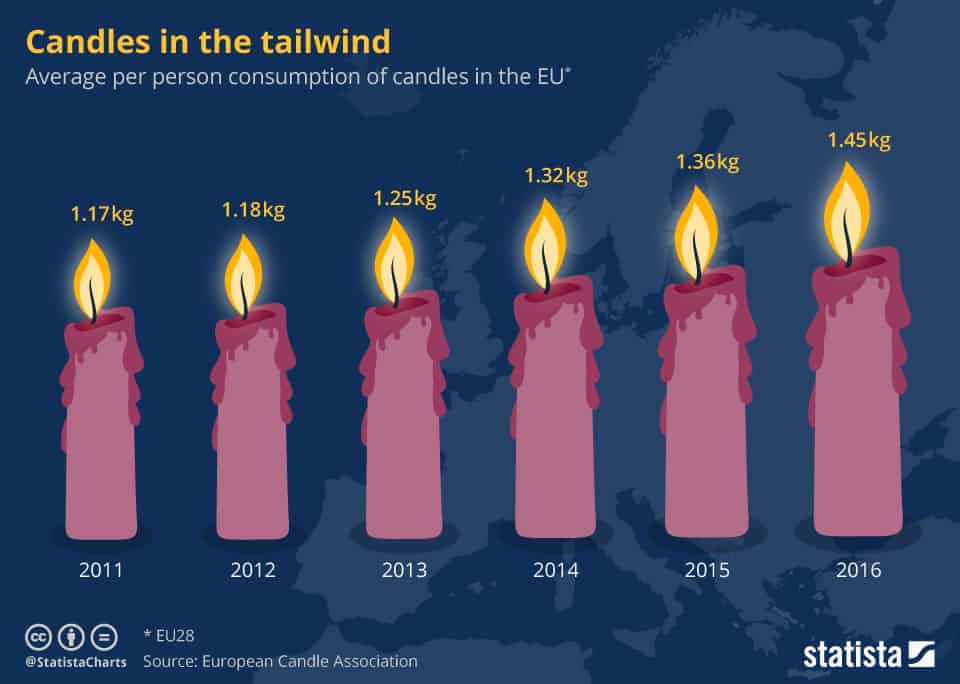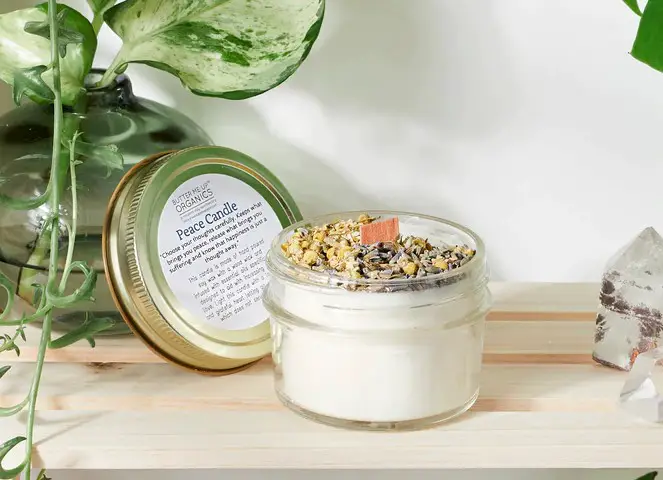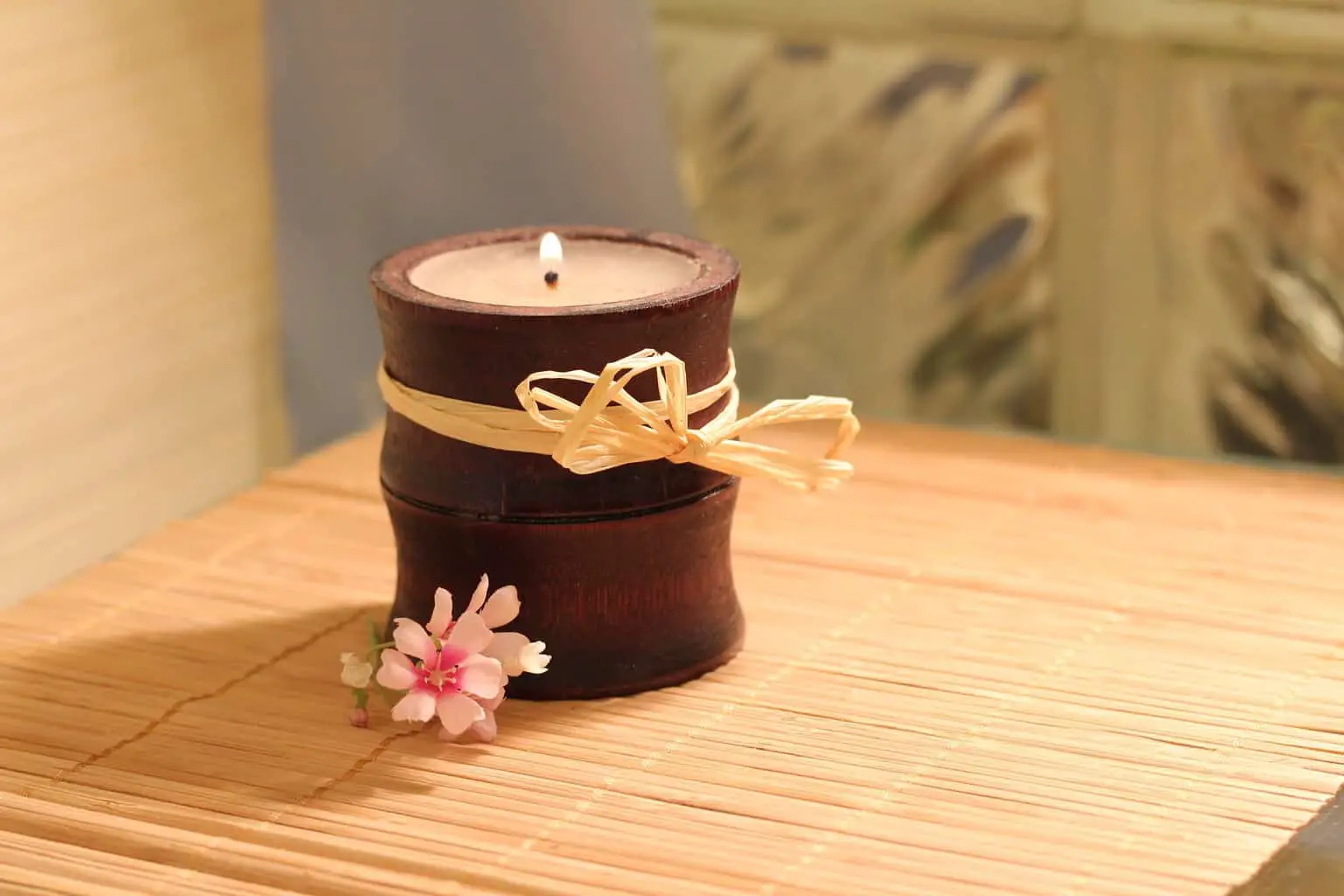Are you sure you’re not unwittingly polluting the air in your home with toxic particles?
For many people, one of life’s simplest and most satisfying pleasures is coming home at the end of a stressful day and lighting a scented candle to make them feel relaxed and at peace.
For others, candles set the mood for dinner parties and backyard get-togethers. They’re also considered a wonderful holiday present, housewarming or hostess gift, and thank-you offering.
Yet seemingly harmless candles may also be filling the air around you with lead emissions and carcinogenic soot.
Fortunately, there are plenty of alternatives to the toxic, chemical-infused aromatherapy candles often found in stores and online.
Here’s how to find safe, environmentally friendly candles that still deliver the soothing effects you’re looking for.
What’s Wrong With “Normal” Candles?
It helps to start with how conventional candles became the norm. In use for over 5000 years, early versions of candles were crafted from natural materials.
Egyptians used animal fat, the Chinese recycled whale fat, and native Alaskans employed fish for their tapers. Beeswax candles were first used in Europe during the Middle Ages.
Then came the industrial revolution and, as with many household products, biodegradable natural ingredients were replaced with by-products of petroleum.
By the 1850s, paraffin – a byproduct of the lubricating oil production – was being used to make cheap candles. These paraffin candles remain the most common form available today.
Interestingly, the popularity and consumption of candles have been seeing a constant growth over the last years.
As an example of this worldwide trend, the European Candle Association has recorded a 24 % rise within the EU between 2011 and 2016 – up to 1.45 kg (3.2 lbs) per person and year.

Paraffin-Based Candles Are a Health Hazard
While they may be affordable, pretty to look at, and come in dozens of scents, paraffin candles are not biodegradable and in fact, are slightly toxic.
The Environmental Protection Agency has released several reports about the health dangers of paraffin candles with synthetic fragrances, lead wicks, and contaminated oils.
Experts have said for many years they may be just as dangerous to your health as secondhand smoke.
Adding to the problem is some mass-produced candle wicks contain heavy metals like lead that release unsafe levels of toxins into the air when burned. This, even though the U.S. requires candle wicks to be made from cotton or paper.
The toxic pollutants released into the air when burning paraffin candles can cause the following serious health problems, to list a few:
- Nervous and brain damage
- Cancer
- Kidney damage
- Allergies and contact eczema
- Impaired mental development in children
The majority of these harmful substances come from colors, scents and fragrances (especially dangerous synthetic fragrances) which are added to the candle wax or wick.
Back in 2009, the South Carolina State University carried out a study which examined the health hazards of paraffin candles and compared them with natural alternative candles.
Here’s what that study found:
“The paraffin candles we tested released unwanted chemicals into the air.
For a person who lights a candle every day for years or just uses them frequently, inhalation of these dangerous pollutants drifting in the air could contribute to the development of health risks like cancer, common allergies and even asthma.
None of the vegetable-based candles produced toxic chemicals.”
Dr. Ruhullah Massoudi – lead researcher
What Are Safe & Eco-Friendly Candles?
As shown by Dr. Massoudi’s study results (as well as many others), candles with wax made from vegetable or other natural materials are clearly the better option.
Both, for your health as well as our environment.
However, the overwhelming number of candles sold – about three quarters – are paraffin candles.
So now that you know that they are neither healthy for you nor good for our environment, what alternatives are there?
Basically, there are three main alternatives to paraffin candles you can choose from:
Stearin Candles
Stearin wax candles are almost always made from palm oil.
However, it can also be made from coconut oil or animal fats – so do pay attention to the ingredients list.
Being a natural resource – unlike the petroleum byproduct paraffin – stearin is completely biodegradable.
Which means you can simply toss your candle residuals into your organic waste or compost.
And since it’s a plant-based product, burning it is actually CO2-neutral.
However, this is only true if no rain forests were cleared for cultivation, which – unfortunately – is not the case with conventional palm oil production.
So be sure to pay attention to the RSPO certificate (“Roundtable on Sustainable Palm Oil”) or an equally independent and reliable certification.
Only then can you be sure that the palm oil was cultivated and produced in a sustainable and eco-friendly manner.
Stearin candles also burn longer and soot and drip significantly less than paraffin candles.
Soy Candles
Soy wax is made from the oil of soybeans and is therefore also a plant-based resource.
This means that it is also biodegradable and basically CO2-neutral.
Also, make sure to get candles which are made from GMO-free soy, whenever possible.
Soy candles tend to be more expensive, but being a high-quality product, they can contribute significantly to creating a certain desired atmosphere.
That’s why they are extremely popular as a gift.
Beeswax Candles
The most natural – and by far the most expensive – raw material for candles is beeswax.
Especially when they come from organic beekeeping, beeswax candles are the most environmentally friendly type.
Nature itself takes care of the production process – the worker bees excrete the wax via glands to build their honeycomb.
The natural limitation of this precious resource also explains the rather high price tag compared to paraffin or vegetable oil wax.
The market share of beeswax candles is, therefore, less than two percent – a true rarity.
Beeswax candles are especially appreciated because of their long burning time and their delicate, natural scent.
Good to know: The term “beeswax candles” may only be used for candles which do not contain any admixture.
So you can be sure they always consist of 100% beeswax.
What to Look Out for When Buying Vegetable Wax Candles
As people learn about these unhealthy side effects of cheap paraffin candles, other alternatives have become more popular.
Candles with waxes made from natural (beeswax) or renewable resources (palm oil or soy) are generally the healthier and more environmentally friendly alternatives to paraffin candles.
But watch out: it’s crucial to pay attention to the quality – or more precisely – to the ingredients.
That’s because there are many producers of soy or stearin candles that add various synthetic materials such as fragrances, dyes and even paraffin to the wax.
But those are exactly the substances we wanted to avoid in the first place.
In fact, to be able to label a product as “soy candle”, only 51% need to be soy, according to FDA rules.
The other 49% can be good old (and toxic) paraffin – which also happens to be a lot cheaper than soy wax.
Stearin candles must contain at least 90% palm oil to be labeled as such – the rest can be paraffin.
In short: while vegetable oil candles can be a clean and healthy alternative to paraffin candles, you need to make sure that what you’re burning is actually 100% what it’s supposed to be.
5 Tips for a Healthy Use Of Eco-Candles
So you’ve switched to natural and sustainable candles and are thus avoiding the majority of paraffin pollution sources from now on – good for you!
Nevertheless – as with any combustion process – even natural candles may release certain pollutants in small quantities due to incomplete combustion.
To reduce this risk even further, it is all about minimizing soot formation.
Check out the following 5 hints & tips for a healthy use of your candles:
- Ensure good ventilation in closed rooms before and especially after use
- Do not blow out candles! Instead, dip the wick into the liquid wax and immediately prop it back up again (e.g. with a match)
- Avoid drafts during use (the flame should not flicker)
- Don’t let the wick become longer than about 0.5 in / 1 cm
- Avoid the formation of “craters” – let the candles burn long enough until the entire wax surface has melted (especially big and wide candles)
5 Great Natural Candle Brands (Soy & Beeswax)
The good news is there are plenty of options to choose from, with more coming on to the market every day.
Many candle makers are choosing to use only beeswax while others prefer 100% soy or even a soy/beeswax combination which is better at holding a scent.
If you’re looking for eco-friendly and healthy candles for yourself or as a gift, here are some of our top recommendations.
1. Butter Me Up Organics – Organic Soy Wax Candle

Butter Me Up Organics, based in Livermore, California, is an eco-friendly and zero-waste brand.
Their products include organic and cruelty-free personal care and home products, made with all-natural, responsibly sourced ingredients that are mainly certified organic, cruelty-free, and fair-trade.
Butter Me Up Organics uses only eco-friendly, plastic-free packaging and all their products are zero-waste.
Their Peace Organic Soy Wax Candle is hand-poured around a wood wick and infused with organic lavender and chamomile essential oils meant to promote a sense of peace and calm.
It is topped with dried chamomile and a handpicked and charged clear quartz crystal.
The candle comes in a glass jar with a metal lid, and the labels are printed on recycled paper with eco-friendly soy-based ink.
It is also cruelty-free and contains no sulfates, phthalates, or parabens, and no synthetic dyes or fragrances.
2. Flores Lane – 100% Soy Wax Candles
L.A.-based Flores Lane was founded by Trish Baden, a Cincinnati native who focuses on eco-friendly ingredients for city-themed candles, with Los Angeles, the South Bay, New York City, and San Francisco all represented.
All of their candles are hand-poured in West Hollywood and made from 100% soy wax.
The company also offers custom candles as well as chakra, meditation, and travel size collections.
What makes Flores Lane unique is that it also holds workshops for people who want to learn how to make their own earth-friendly candles.
3. Bee Hive Candles – 100% Beeswax Candles
Bee Hive Candles was founded when Jennifer Wesolowski took the step from making candles as a hobby for personal use and friends to professional chandler.
Her passion for bees and beeswax had been kindled many years earlier when she was a beekeeper for a honey farm in Minnesota.
All of their candles are made from 100% pure U.S. beeswax, hand-poured and without any additives or fillers.
Only essential oils or eco-friendly colors are added to some of their candles to scent or color them.
Even better, the company uses only minimal packaging in an effort to keep waste to a minimum. For example, they do not shrink wrap their candles in plastic but wrap them in paper.
To reduce the environmental impact even further, their production workshop is powered by 100% renewable energies such as solar, biomass or wind.
Giving back and helping those who need help is very important to the company, which is why they support charities around the country, like the St Jude Children’s Hospital.
If you’re from Europe and looking for an equally great beeswax candle brand, we highly recommend “Figura Santa”.
They are manufactured in Germany’s Black Forest and made of 100% beeswax in highest beekeeping quality.
The wax is completely free from any additives. The candles are certified according to the quality guidelines of the European Pharmacopoeia.
4. La Jolie Muse – 100% Soy Wax Candle in Glass & Gift Box
As mentioned earlier, soy candles are especially popular as gifts.
This model here by La Jolíe Muse is a great example of such a high-end candle – both qualitatively and visually.
It is delivered in a noble gift box, the candle itself sits in a high-quality glass container.
The candle is made from 100% biodegradable soy wax and offers a long burning time of up to 65 hours.
5. Peripeti Candles – 100% Soy Wax Candles
Peripeti Candles offers handmade products with non-toxic fragrances created from soy wax and essential oils.
The Cleveland-based company uses only quality, all-natural ingredients (no chemical dyes or additives).
Additionally, the soy they use is sourced from the U.S. and approved by the ASA (American Soy Association) which means it meets sustainability criteria.
And all their candles are 100% infused with fragrance meaning the scent throw lasts until the final burn and has “lift,” meaning you can smell it even when the candle isn’t burning.
Conclusion
The feel-good emotions linked to scented candles will always make them a treasured element of many homes.
Non-toxic candles made from clean-burning beeswax or vegetable wax have a minimum impact on the environment yet still deliver maximum joy.
And what could be more natural than that?
You Might Also Like…
- Is Fast Food Bad for the Environment? (& What You Can Do)
- Is Fabric Softener Bad for the Environment? (+5 Eco-Friendly Options)
- Is Fuel Dumping Bad for the Environment? (& How Often It Happens)
- Is Electricity Generation Bad for the Environment? (What You Should Know)
- Is Dry Cleaning Bad for the Environment? (4 Surprising Facts)
- Is Diamond Mining Bad for the Environment? (Important Facts)
- Is DEET Bad for the Environment? 4 Effects (You Should Know)
- Is Cat Litter Bad for the Environment? (5 Common Questions)
- Is Burning Cardboard Bad for the Environment? (6 Facts)
- Is Burning Paper Bad for the Environment? (6 Surprising Facts)
- Is Burning Leaves Bad for the Environment? (7 Quick Facts)
- 4 Natural Cleaners for Quartz Countertops
- 6 Eco-Friendly Acrylic Paint Brands (For Sustainable Artists)
- 5 Eco-friendly Alternatives to Acrylic Paint (& How to Make Them)
- Is Acrylic Paint Bad for the Environment? (7 Quick Facts)
- Is Acrylic Yarn Bad for the Environment? 8 Crucial Facts
- Is Acrylic Bad for the Environment? (8 Quick Facts)
- Is Aluminum Foil Bad for the Environment? 7 Quick Facts
- Is Bleach Bad for the Environment? 6 Crucial Facts
- Is Lithium Mining Bad for the Environment? 6 Crucial Facts



































